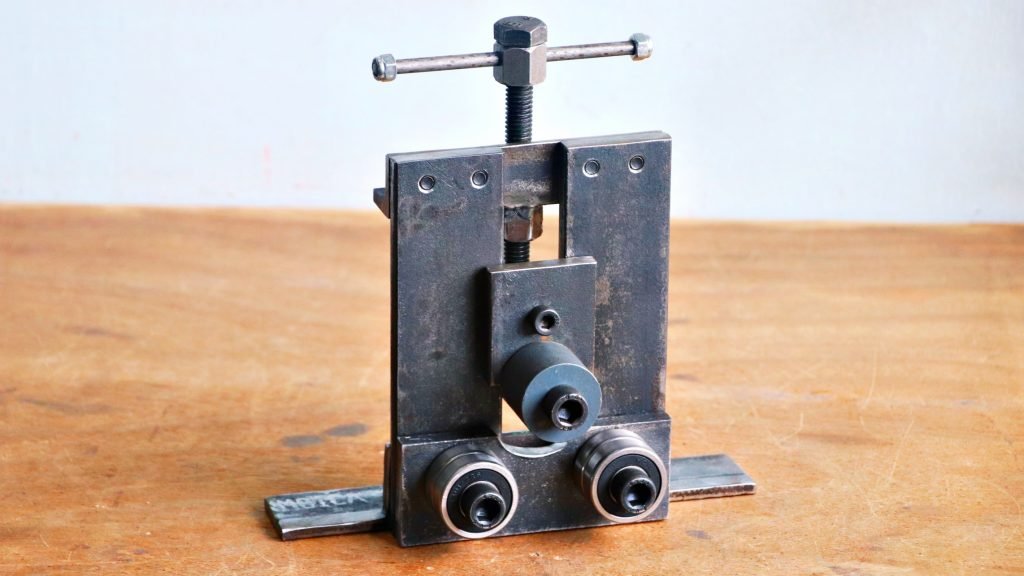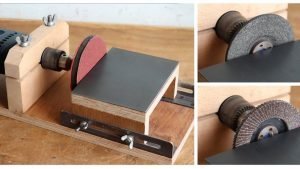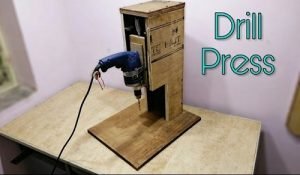
INTRODUCTION :
The roller bender is a mechanical device or jig having three rollers used to form a metal bar or rod into a circular arc. The rollers are freely rotate about three parallel axes, which are arranged with uniform horizontal spacing. Two outer rollers, cradle the bottom of the material while the inner roller, whose position is adjustable, presses on the topside of the material.
In this mechanism, after the bar is initially inserted into the jig, the middle roller is manually lowered and forced against the bar or rod with a screw arrangement. This causes the bar or rod to undergo plastic and elastic deformation.
The main problem that people, doing various metallic projects, face is the bending of metallic pieces. The reason that this problem is arisen during these projects is because the metallic pieces need a lot of pressure, strength as well as accuracy to be bent. There are many machines to be used to achieve this but the cost is very high. Therefore, I decided to make for my own. The construction of this roller bender is more user-friendly to everyone, is relatively affordable, is extremely useful and it will fill with feelings of joy and satisfaction the people who want to spend their time productively.
Parts Used :
- L-Section channel 1.25”*1.25” width (5mm thickness) 9” length for base
- L-Section channel 1.25”*1.25 width (5mm thickness) 5” length
- L-Section channel 1.25”*1.25” width (5mm thickness) 2” length
- 2 Nos. metal pieces 2”*7” (10mm thickness)
- Metal piece 2”*2” (10mm thickness)
- Metal piece 5”*2” (10mm thickness)
- Metal piece 5”*1” (5mm thickness)
- 4 Nos. 6301-2RS bearings
- M12 Bolt (5” length) with 2 nuts
- M10 Bolt (3” length) with nut
- 3 Nos. M12 allenky bolts (3” length) with nuts
- 5 Nos. M8 allenky bolts (1” length)
- 2 Nos. M4 allenky bolts (1” length)
- Cylindrical metal piece (1.5” diameter)12.5mm hole
How to make :
Step 1 :- Cutting of parts

First step to make roller bender is cutting of all metal parts to its desired dimension. You can see all the dimension of cutting parts in “parts used”. In this metal bender machine, I have used 4 bearings to use as a roller, also one cylindrical metal piece of 1.5” diameter. This cylindrical metal piece is middle roller and it is manually lowered and forced against the bar or rod with a screw arrangement.
Step 2 :- Assembly of all cutting parts
This is the second step to make roller bender, assembly of all cutting parts. For assembly of parts I have used allenky bolts, I have not doing any type of weld for assembly of cutting parts. 4 bearings are attached with base (L-Section channel 1.25”*1.25” (5mm thickness) 9” length for base), Metal piece 5”*2” (10mm thickness) and 2 Nos. metal pieces of 2”*7” (10mm thickness) by using of M12 allenky bolts (3” length).


Also attach the L-Section channel 1.25”*1.25 width (5mm thickness) 5” length on other side of the metal pieces of 2”*7” by using of 4 Nos. M10 allenky bolts.

Next step is assembly of M12 Bolt (5” length) with 2 nuts and middle roller (Cylindrical metal piece (1.5” diameter) and 12.5mm hole).


This M12 bolt is provide the screw arrangement to manually lowered and forced the middle roller against the bar or rod, and at the last attach the handle to rotate the middle roller.

Handle is attached with middle roller by using of 2 Nos. M4 allenky bolts (1” length). I have used M10 Bolt (3” length) with nut, metal piece 5”*1” (5mm thickness) and wooden cylindrical piece to make handle.

Step 3 :- Ready to use
Now the roller bender is ready to use. In this mechanism, after the bar is initially inserted between the three rollers, the middle roller is manually lowered and forced against the bar or rod with a screw arrangement. This causes the bar or rod to undergo plastic and elastic deformation.

The bar between the three rollers will take on the shape of a cubic polynomial, which approximates a circular arc. The three rollers are then rotated moving the bar along with them. For each new position, the portion of the bar between the three rollers takes on the shape of a cubic modified by the end conditions imposed by the adjacent sections of the bar. When either end of the bar is reached, the force applied to the centre roller is incrementally increased, the roller rotation is reversed and as the rolling process proceeds, the bar shape becomes a better approximation to a circular arc, gradually, for the number of passes required to bring the arc of the bar to the desired radius.









Informative article, totally what I was looking for.
Keep this going please, great job!
Hey very nice blog!
Thanks for another informative blog. The place else could I
get that type of information written in such a perfect
method? I’ve a project that I’m simply now working on, and
I have been on the look out for such information.
This is really interesting, You are a very skilled blogger.
I’ve joined your rss feed and look forward to seeking more of your magnificent post.
Also, I have shared your web site in my social
networks!